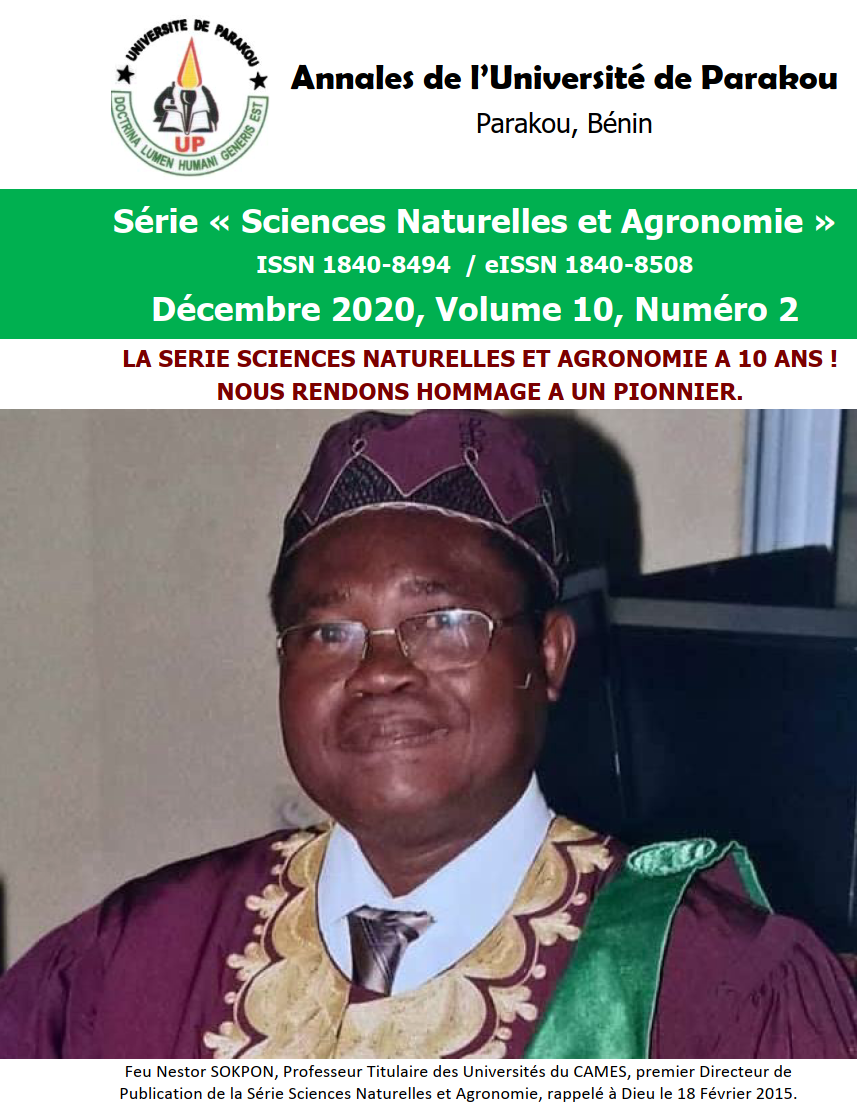Physical characteristics of some banana plantain cultivars (Musa spp.) consumed in Benin
DOI:
https://doi.org/10.56109/aup-sna.v10i2.33Keywords:
Horticultural crops, plantain, weight, flour yield, dry matterAbstract
Plantains (Musa spp) are among the most important cultivated horticultural crops in West Africa. Various varieties and cultivars are produced in Benin. This study aimed at evaluating the physical characteristics and some proximate composition of some plantain cultivars consumed in Benin. Physical parameters including weight of the bunch, number of hands and fingers, weight of hands and finger, pulp percentage and flour yield were assessed using five cultivars of plantain (Aloga, Aloga 2M, Gnivlan, Kpahissi, Orishele) and one cooking banana (Pelipita). In addition, color parameters, dry matter as well as total minerals contents were assessed for the pulp of the various cultivars. It came out that Kpahissi cultivars had heavier bunches and a lot of hands than the other cultivars while Aloga 2M had the highest weight of hands and fingers. Finger number varied from 2 to 12 among the six cultivars. The pulp percentage ranged from 51.3 to 70.71%. Kpahissi pulp was brighter but less yellow and red than the other pulps cultivars. Significant differences were observed in dry matter and total minerals contents of pulps with highest values for Pelipita pulp. This study provides baseline information on plantain diversity in terms of their physical characteristics in Benin. Results can be helpful in the choice of plantain bunches during purchasing.
Downloads
Metrics
References
Ajayi A. R. & Aneke M. O. 2002. Consumption and expenditure patterns of banana and plantain consumers in Nsukka Urban. Nigeria. InfoMusa, 11: 50-53.
Annor G. A. Asamoah-Bonti P. & Sakyi-Dawson E. 2016. Fruit physical characteristics, proximate, mineral and starch characterization of FHIA 19 and FHIA 20 plantain and FHIA 03 cooking banana hybrids. SpringerPlus, 5:796-808. DOI: https://doi.org/10.1186/s40064-016-2465-1
AOAC. 2002. Official Methods of Analysis.16th edn: Association of Official Analytical Chemists, Washington DC.
Britton G. & Khachik F. 2009. Carotenoids in food: 45-66. In: Britton G. Liaaen-Jensen S. & Pfander H. P. (Eds.). Nutrition and health, Volume 5. Basel: Birkhäuser Verlag. DOI: https://doi.org/10.1007/978-3-7643-7501-0_3
Baiyeri K. P. Aba. S. C. Otitoju G. T. & Mbah O. B. 2011. The effects of ripening and cooking method on mineral and proximate composition of plantain (Musa sp. AAB cv. ‘Agbagba’ fruit pulp). Africa. J. Biotechnol. 10 (36): 6979-6984.
Chabi C. M. Dassou G. A. Dossou-Aminon I. Ogouchoro J. Omondi Aman B. & Dansi A. 2018. Banana and plantain production systems in Benin: ethnobotanical investigation, varietal diversity, pests, and implications for better production. J. Ethnobiology Ethnomedicine 14(78): 1884-1902. DOI: https://doi.org/10.1186/s13002-018-0280-1
Dadzie B. K. & Orchard J.E. 1997. Routine Post-Harvest Screening of Banana/Plantain Hybrids: Criteria and Methods. Technical guidelines INIBAP Vol 2.
Dadize B. K. 1998. Post-harvest characteristics of black Sigotoka resistant banana, cooking banana and plantain hybrids. Technical guidelines INIBAP Vol 4.
FAOSTAT. 2019. Production de la banane plantain http://www.fao.org/faostat/fr/#data/QC, (accessed the 13/01/2020), FAO, Rome.
Ferris R. S. B. Ortiz R. & Vuylsteke D. 1999. Fruit quality evaluation of plantains, plantain hybrids, and cooking bananas. Postharvest Biology Technol. 15: 73-81. DOI: https://doi.org/10.1016/S0925-5214(98)00067-2
Gandonou G. Ahanhanzo C. Agbangla C. Agbidinoukoun A. Doussoh A. Cacai G. & Dossoukpevi R. 2012. Micropropagation in vitro de la variété locale «Aloga» du bananier plantain (Musa x paradisiaca L.) au Bénin. Int. J. Biol. Chem. Sci. 6(3): 1102-1111. DOI: https://doi.org/10.4314/ijbcs.v6i3.16
IITA. 2000. Improving plantain and Banana based. International Institute of Tropical Agriculture. Project 2; Annual report, Ibadan, p.67.
John P. & Marchal J. 1995. Ripening and biochemistry of the fruit: 18-25. In: Gowen S. R. (ed.). Bananas and Plantains, Chapman and Hall, London, UK. DOI: https://doi.org/10.1007/978-94-011-0737-2_15
Kpenavoun Chogou S. Abokini E. Togbe E. Ahohouendo A. Odjo C. Egounlety Biokou A. G. Honfo G. F. Affokpon A. Adjadogbedji B. Adimou J. B. Nanoukon B. & Ahohuendo C. B. 2019. Étude de référence du projet Avlanto-Bénin. Rapport d’enquête, Cotonou Bénin, 71p.
Ngoh Newilah G. 2005. Utilisation alimentaire, caractérisation physicochimique et biochimique des fruits de quelques cultivars et hybrides de bananiers et plantains produits au Cameroun. PhD Thesis, Université de Yaoundé. Yaoundé, Cameroun, 131p.
Ngoh Newilah G. Tchango Tchango J. Fokou E. & Etoa F. X. 2005. Processing and food uses of bananas and plantains in Cameroon. Fruits. 60 (4): 245-253. DOI: https://doi.org/10.1051/fruits:2005031
Wainwright H & Hughes P. 1989. Objective measurement of banana pulp color. Int. J. Food Sci. Technol. 24:553-8. DOI: https://doi.org/10.1111/j.1365-2621.1989.tb00679.x
Downloads
Published
How to Cite
Issue
Section
Categories
License
Copyright (c) 2020 Fernande HONFO, Euloge C. TOGBE, Alain F. AHOHOUENDO, Bonaventure C. AHOHUENDO

This work is licensed under a Creative Commons Attribution 4.0 International License.













